Health Reforms and Controversies in the U.S. Healthcare System
VerifiedAdded on 2022/11/28
|11
|2774
|209
AI Summary
This article explores the impact of health care reforms and controversies in the U.S. healthcare system. It discusses the Affordable Care Act, Medicaid expansion, and ongoing debates surrounding healthcare access and cost. The article also provides recommendations for improving the healthcare system.
Contribute Materials
Your contribution can guide someone’s learning journey. Share your
documents today.

Running head: APPLIED BIOSTATISTICS 1
Applied Biostatistics
Name
Institution
Applied Biostatistics
Name
Institution
Secure Best Marks with AI Grader
Need help grading? Try our AI Grader for instant feedback on your assignments.
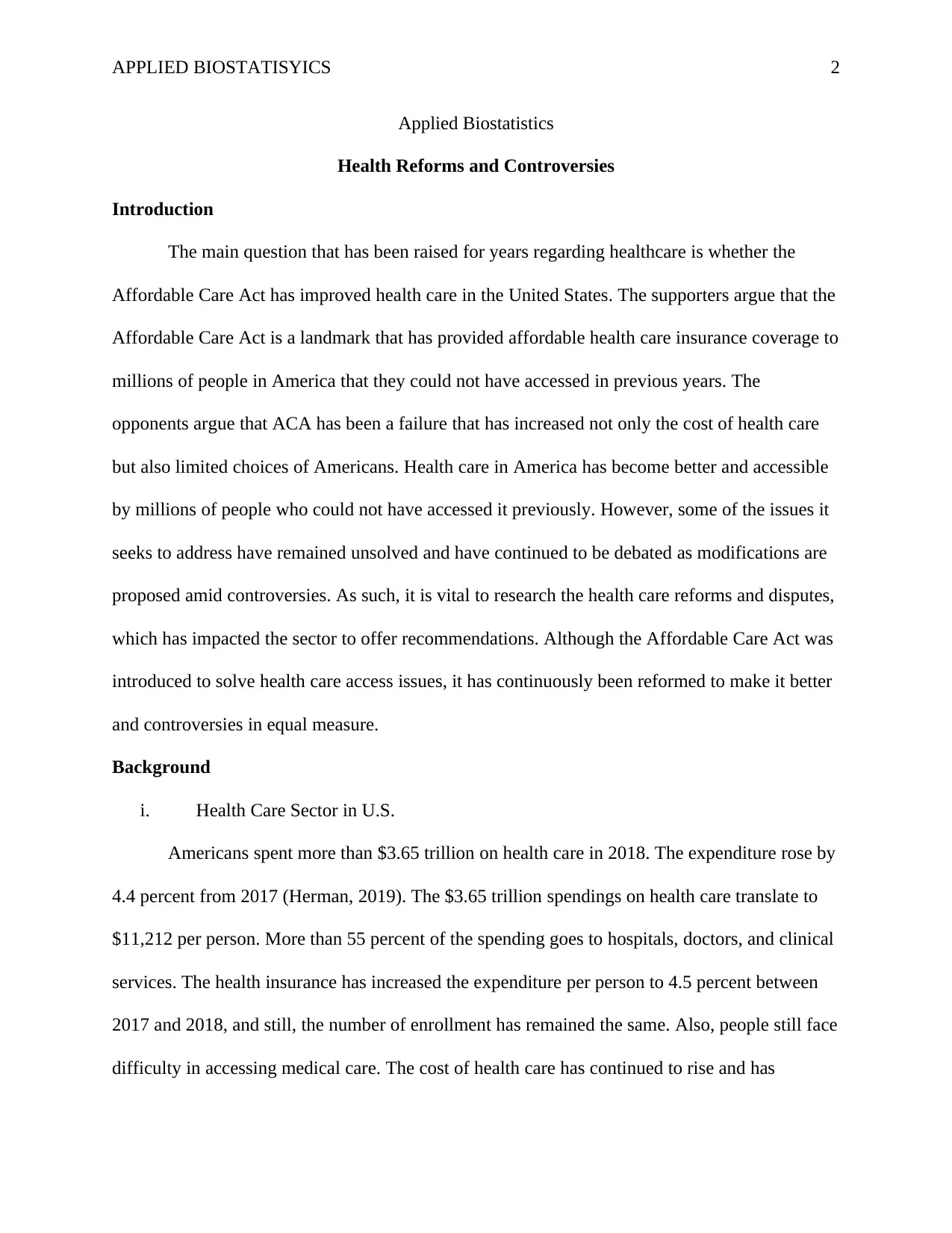
APPLIED BIOSTATISYICS 2
Applied Biostatistics
Health Reforms and Controversies
Introduction
The main question that has been raised for years regarding healthcare is whether the
Affordable Care Act has improved health care in the United States. The supporters argue that the
Affordable Care Act is a landmark that has provided affordable health care insurance coverage to
millions of people in America that they could not have accessed in previous years. The
opponents argue that ACA has been a failure that has increased not only the cost of health care
but also limited choices of Americans. Health care in America has become better and accessible
by millions of people who could not have accessed it previously. However, some of the issues it
seeks to address have remained unsolved and have continued to be debated as modifications are
proposed amid controversies. As such, it is vital to research the health care reforms and disputes,
which has impacted the sector to offer recommendations. Although the Affordable Care Act was
introduced to solve health care access issues, it has continuously been reformed to make it better
and controversies in equal measure.
Background
i. Health Care Sector in U.S.
Americans spent more than $3.65 trillion on health care in 2018. The expenditure rose by
4.4 percent from 2017 (Herman, 2019). The $3.65 trillion spendings on health care translate to
$11,212 per person. More than 55 percent of the spending goes to hospitals, doctors, and clinical
services. The health insurance has increased the expenditure per person to 4.5 percent between
2017 and 2018, and still, the number of enrollment has remained the same. Also, people still face
difficulty in accessing medical care. The cost of health care has continued to rise and has
Applied Biostatistics
Health Reforms and Controversies
Introduction
The main question that has been raised for years regarding healthcare is whether the
Affordable Care Act has improved health care in the United States. The supporters argue that the
Affordable Care Act is a landmark that has provided affordable health care insurance coverage to
millions of people in America that they could not have accessed in previous years. The
opponents argue that ACA has been a failure that has increased not only the cost of health care
but also limited choices of Americans. Health care in America has become better and accessible
by millions of people who could not have accessed it previously. However, some of the issues it
seeks to address have remained unsolved and have continued to be debated as modifications are
proposed amid controversies. As such, it is vital to research the health care reforms and disputes,
which has impacted the sector to offer recommendations. Although the Affordable Care Act was
introduced to solve health care access issues, it has continuously been reformed to make it better
and controversies in equal measure.
Background
i. Health Care Sector in U.S.
Americans spent more than $3.65 trillion on health care in 2018. The expenditure rose by
4.4 percent from 2017 (Herman, 2019). The $3.65 trillion spendings on health care translate to
$11,212 per person. More than 55 percent of the spending goes to hospitals, doctors, and clinical
services. The health insurance has increased the expenditure per person to 4.5 percent between
2017 and 2018, and still, the number of enrollment has remained the same. Also, people still face
difficulty in accessing medical care. The cost of health care has continued to rise and has
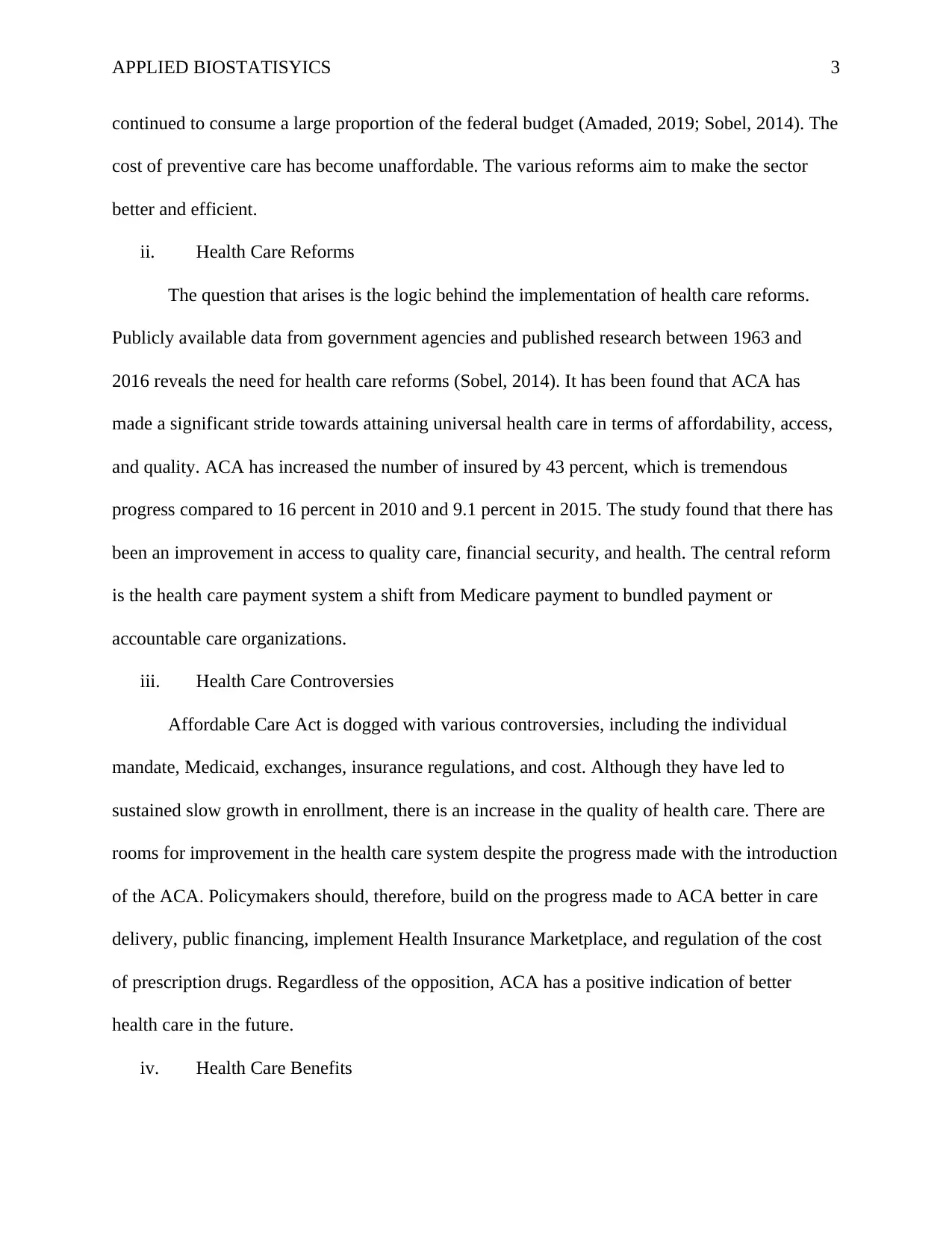
APPLIED BIOSTATISYICS 3
continued to consume a large proportion of the federal budget (Amaded, 2019; Sobel, 2014). The
cost of preventive care has become unaffordable. The various reforms aim to make the sector
better and efficient.
ii. Health Care Reforms
The question that arises is the logic behind the implementation of health care reforms.
Publicly available data from government agencies and published research between 1963 and
2016 reveals the need for health care reforms (Sobel, 2014). It has been found that ACA has
made a significant stride towards attaining universal health care in terms of affordability, access,
and quality. ACA has increased the number of insured by 43 percent, which is tremendous
progress compared to 16 percent in 2010 and 9.1 percent in 2015. The study found that there has
been an improvement in access to quality care, financial security, and health. The central reform
is the health care payment system a shift from Medicare payment to bundled payment or
accountable care organizations.
iii. Health Care Controversies
Affordable Care Act is dogged with various controversies, including the individual
mandate, Medicaid, exchanges, insurance regulations, and cost. Although they have led to
sustained slow growth in enrollment, there is an increase in the quality of health care. There are
rooms for improvement in the health care system despite the progress made with the introduction
of the ACA. Policymakers should, therefore, build on the progress made to ACA better in care
delivery, public financing, implement Health Insurance Marketplace, and regulation of the cost
of prescription drugs. Regardless of the opposition, ACA has a positive indication of better
health care in the future.
iv. Health Care Benefits
continued to consume a large proportion of the federal budget (Amaded, 2019; Sobel, 2014). The
cost of preventive care has become unaffordable. The various reforms aim to make the sector
better and efficient.
ii. Health Care Reforms
The question that arises is the logic behind the implementation of health care reforms.
Publicly available data from government agencies and published research between 1963 and
2016 reveals the need for health care reforms (Sobel, 2014). It has been found that ACA has
made a significant stride towards attaining universal health care in terms of affordability, access,
and quality. ACA has increased the number of insured by 43 percent, which is tremendous
progress compared to 16 percent in 2010 and 9.1 percent in 2015. The study found that there has
been an improvement in access to quality care, financial security, and health. The central reform
is the health care payment system a shift from Medicare payment to bundled payment or
accountable care organizations.
iii. Health Care Controversies
Affordable Care Act is dogged with various controversies, including the individual
mandate, Medicaid, exchanges, insurance regulations, and cost. Although they have led to
sustained slow growth in enrollment, there is an increase in the quality of health care. There are
rooms for improvement in the health care system despite the progress made with the introduction
of the ACA. Policymakers should, therefore, build on the progress made to ACA better in care
delivery, public financing, implement Health Insurance Marketplace, and regulation of the cost
of prescription drugs. Regardless of the opposition, ACA has a positive indication of better
health care in the future.
iv. Health Care Benefits
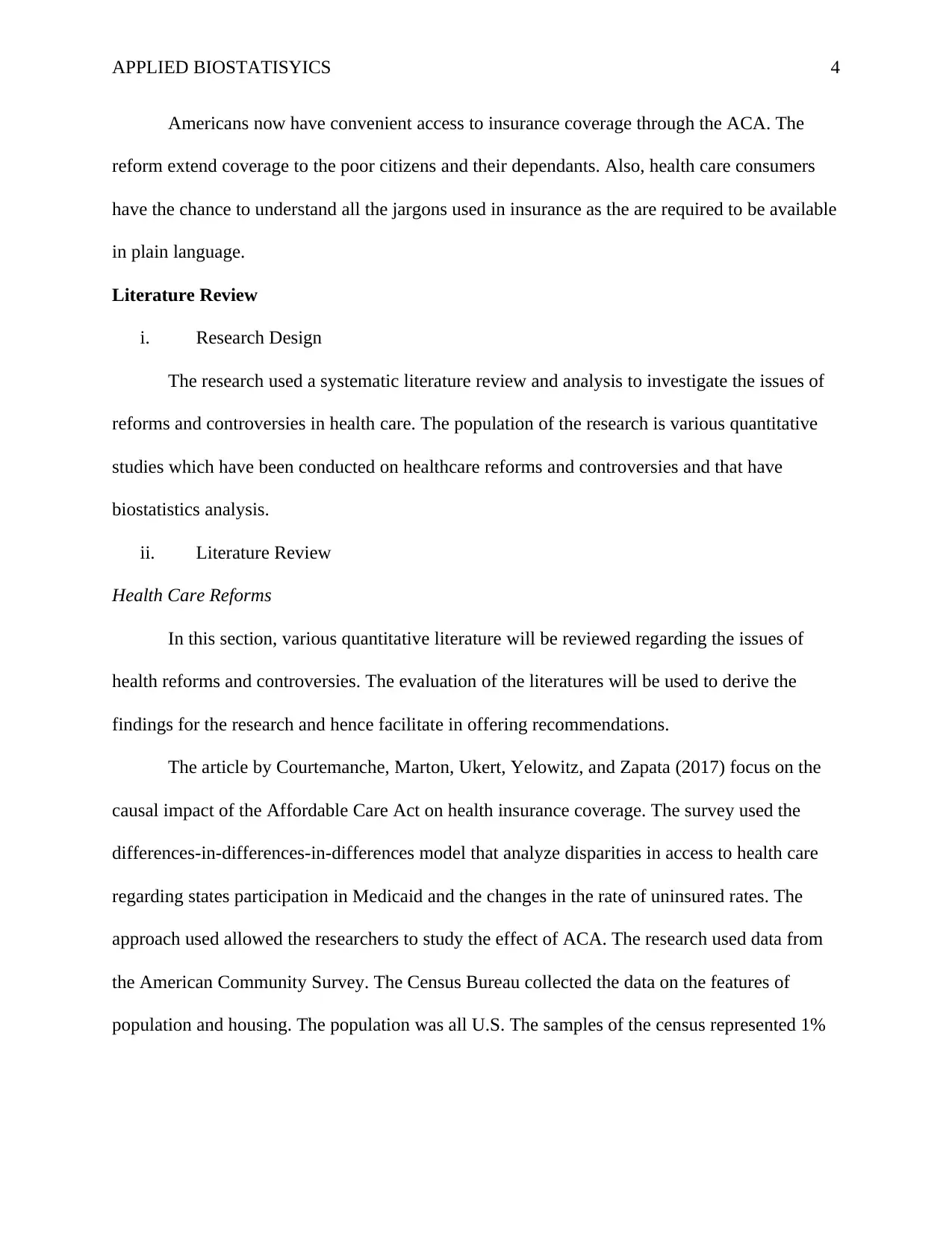
APPLIED BIOSTATISYICS 4
Americans now have convenient access to insurance coverage through the ACA. The
reform extend coverage to the poor citizens and their dependants. Also, health care consumers
have the chance to understand all the jargons used in insurance as the are required to be available
in plain language.
Literature Review
i. Research Design
The research used a systematic literature review and analysis to investigate the issues of
reforms and controversies in health care. The population of the research is various quantitative
studies which have been conducted on healthcare reforms and controversies and that have
biostatistics analysis.
ii. Literature Review
Health Care Reforms
In this section, various quantitative literature will be reviewed regarding the issues of
health reforms and controversies. The evaluation of the literatures will be used to derive the
findings for the research and hence facilitate in offering recommendations.
The article by Courtemanche, Marton, Ukert, Yelowitz, and Zapata (2017) focus on the
causal impact of the Affordable Care Act on health insurance coverage. The survey used the
differences-in-differences-in-differences model that analyze disparities in access to health care
regarding states participation in Medicaid and the changes in the rate of uninsured rates. The
approach used allowed the researchers to study the effect of ACA. The research used data from
the American Community Survey. The Census Bureau collected the data on the features of
population and housing. The population was all U.S. The samples of the census represented 1%
Americans now have convenient access to insurance coverage through the ACA. The
reform extend coverage to the poor citizens and their dependants. Also, health care consumers
have the chance to understand all the jargons used in insurance as the are required to be available
in plain language.
Literature Review
i. Research Design
The research used a systematic literature review and analysis to investigate the issues of
reforms and controversies in health care. The population of the research is various quantitative
studies which have been conducted on healthcare reforms and controversies and that have
biostatistics analysis.
ii. Literature Review
Health Care Reforms
In this section, various quantitative literature will be reviewed regarding the issues of
health reforms and controversies. The evaluation of the literatures will be used to derive the
findings for the research and hence facilitate in offering recommendations.
The article by Courtemanche, Marton, Ukert, Yelowitz, and Zapata (2017) focus on the
causal impact of the Affordable Care Act on health insurance coverage. The survey used the
differences-in-differences-in-differences model that analyze disparities in access to health care
regarding states participation in Medicaid and the changes in the rate of uninsured rates. The
approach used allowed the researchers to study the effect of ACA. The research used data from
the American Community Survey. The Census Bureau collected the data on the features of
population and housing. The population was all U.S. The samples of the census represented 1%
Secure Best Marks with AI Grader
Need help grading? Try our AI Grader for instant feedback on your assignments.
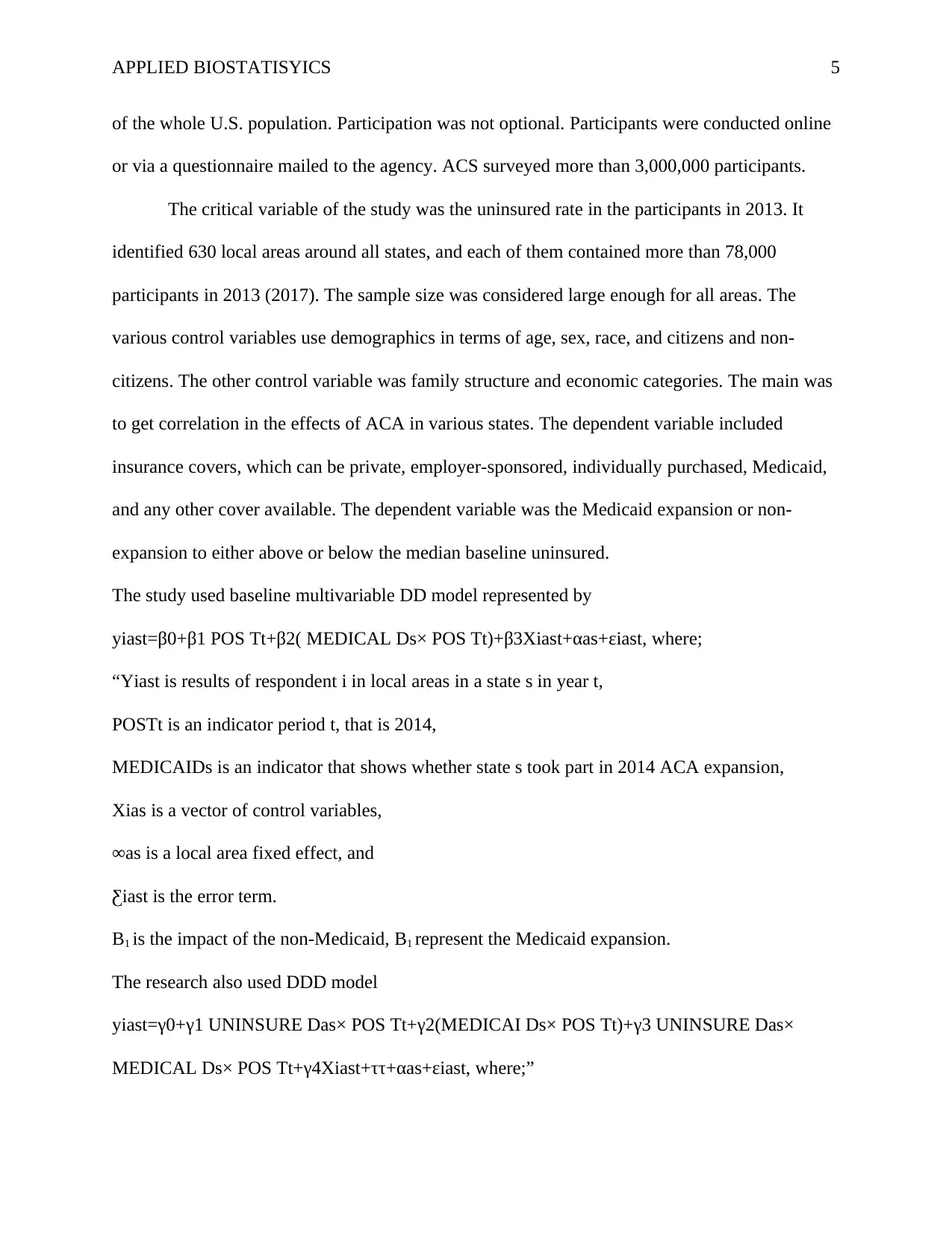
APPLIED BIOSTATISYICS 5
of the whole U.S. population. Participation was not optional. Participants were conducted online
or via a questionnaire mailed to the agency. ACS surveyed more than 3,000,000 participants.
The critical variable of the study was the uninsured rate in the participants in 2013. It
identified 630 local areas around all states, and each of them contained more than 78,000
participants in 2013 (2017). The sample size was considered large enough for all areas. The
various control variables use demographics in terms of age, sex, race, and citizens and non-
citizens. The other control variable was family structure and economic categories. The main was
to get correlation in the effects of ACA in various states. The dependent variable included
insurance covers, which can be private, employer-sponsored, individually purchased, Medicaid,
and any other cover available. The dependent variable was the Medicaid expansion or non-
expansion to either above or below the median baseline uninsured.
The study used baseline multivariable DD model represented by
yiast=β0+β1 POS Tt+β2( MEDICAL Ds× POS Tt)+β3Xiast+αas+εiast, where;
“Yiast is results of respondent i in local areas in a state s in year t,
POSTt is an indicator period t, that is 2014,
MEDICAIDs is an indicator that shows whether state s took part in 2014 ACA expansion,
Xias is a vector of control variables,
∞as is a local area fixed effect, and
Ƹiast is the error term.
Β1 is the impact of the non-Medicaid, Β1 represent the Medicaid expansion.
The research also used DDD model
yiast=γ0+γ1 UNINSURE Das× POS Tt+γ2(MEDICAI Ds× POS Tt)+γ3 UNINSURE Das×
MEDICAL Ds× POS Tt+γ4Xiast+ττ+αas+εiast, where;”
of the whole U.S. population. Participation was not optional. Participants were conducted online
or via a questionnaire mailed to the agency. ACS surveyed more than 3,000,000 participants.
The critical variable of the study was the uninsured rate in the participants in 2013. It
identified 630 local areas around all states, and each of them contained more than 78,000
participants in 2013 (2017). The sample size was considered large enough for all areas. The
various control variables use demographics in terms of age, sex, race, and citizens and non-
citizens. The other control variable was family structure and economic categories. The main was
to get correlation in the effects of ACA in various states. The dependent variable included
insurance covers, which can be private, employer-sponsored, individually purchased, Medicaid,
and any other cover available. The dependent variable was the Medicaid expansion or non-
expansion to either above or below the median baseline uninsured.
The study used baseline multivariable DD model represented by
yiast=β0+β1 POS Tt+β2( MEDICAL Ds× POS Tt)+β3Xiast+αas+εiast, where;
“Yiast is results of respondent i in local areas in a state s in year t,
POSTt is an indicator period t, that is 2014,
MEDICAIDs is an indicator that shows whether state s took part in 2014 ACA expansion,
Xias is a vector of control variables,
∞as is a local area fixed effect, and
Ƹiast is the error term.
Β1 is the impact of the non-Medicaid, Β1 represent the Medicaid expansion.
The research also used DDD model
yiast=γ0+γ1 UNINSURE Das× POS Tt+γ2(MEDICAI Ds× POS Tt)+γ3 UNINSURE Das×
MEDICAL Ds× POS Tt+γ4Xiast+ττ+αas+εiast, where;”
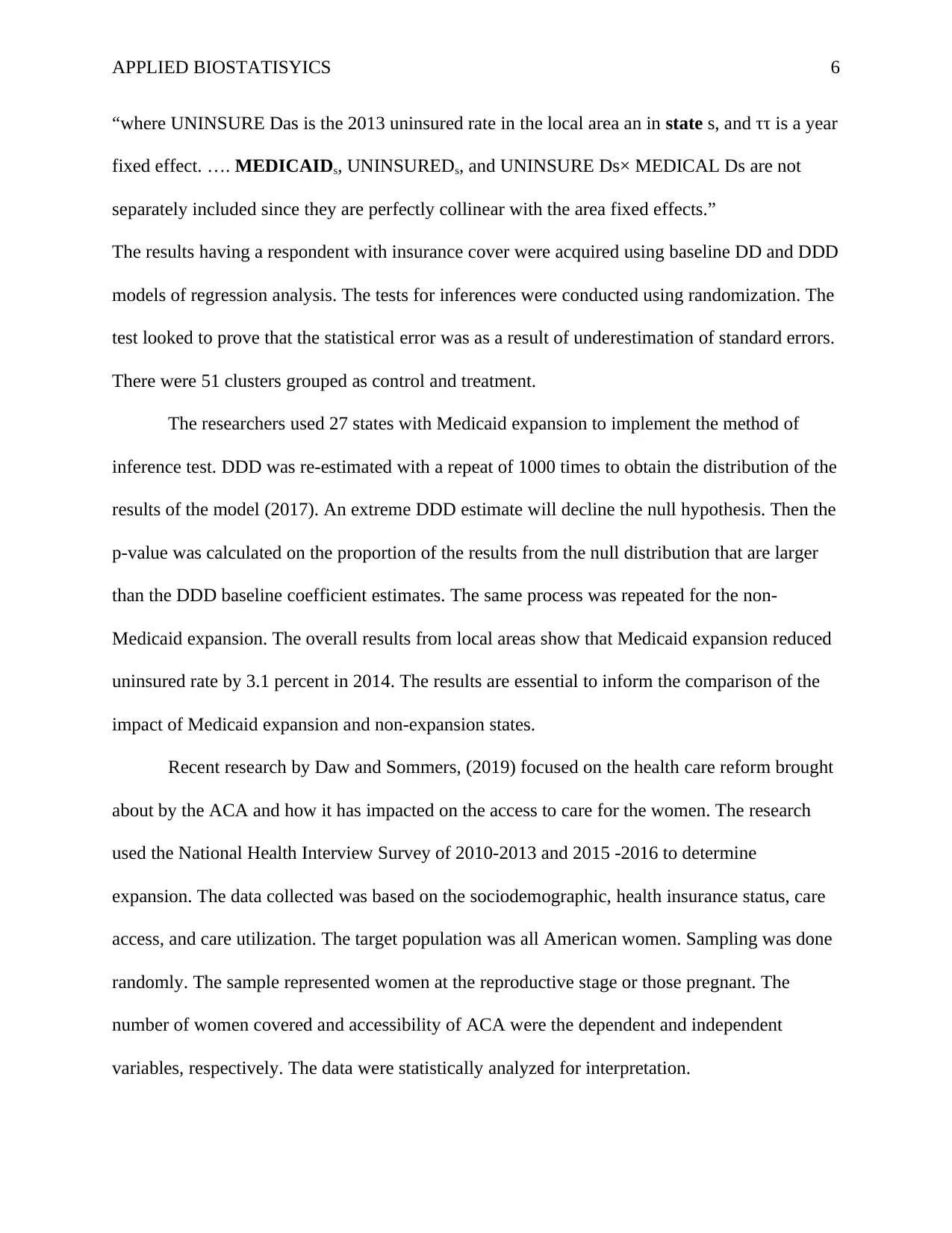
APPLIED BIOSTATISYICS 6
“where UNINSURE Das is the 2013 uninsured rate in the local area an in state s, and ττ is a year
fixed effect. …. MEDICAIDs, UNINSUREDs, and UNINSURE Ds× MEDICAL Ds are not
separately included since they are perfectly collinear with the area fixed effects.”
The results having a respondent with insurance cover were acquired using baseline DD and DDD
models of regression analysis. The tests for inferences were conducted using randomization. The
test looked to prove that the statistical error was as a result of underestimation of standard errors.
There were 51 clusters grouped as control and treatment.
The researchers used 27 states with Medicaid expansion to implement the method of
inference test. DDD was re-estimated with a repeat of 1000 times to obtain the distribution of the
results of the model (2017). An extreme DDD estimate will decline the null hypothesis. Then the
p-value was calculated on the proportion of the results from the null distribution that are larger
than the DDD baseline coefficient estimates. The same process was repeated for the non-
Medicaid expansion. The overall results from local areas show that Medicaid expansion reduced
uninsured rate by 3.1 percent in 2014. The results are essential to inform the comparison of the
impact of Medicaid expansion and non-expansion states.
Recent research by Daw and Sommers, (2019) focused on the health care reform brought
about by the ACA and how it has impacted on the access to care for the women. The research
used the National Health Interview Survey of 2010-2013 and 2015 -2016 to determine
expansion. The data collected was based on the sociodemographic, health insurance status, care
access, and care utilization. The target population was all American women. Sampling was done
randomly. The sample represented women at the reproductive stage or those pregnant. The
number of women covered and accessibility of ACA were the dependent and independent
variables, respectively. The data were statistically analyzed for interpretation.
“where UNINSURE Das is the 2013 uninsured rate in the local area an in state s, and ττ is a year
fixed effect. …. MEDICAIDs, UNINSUREDs, and UNINSURE Ds× MEDICAL Ds are not
separately included since they are perfectly collinear with the area fixed effects.”
The results having a respondent with insurance cover were acquired using baseline DD and DDD
models of regression analysis. The tests for inferences were conducted using randomization. The
test looked to prove that the statistical error was as a result of underestimation of standard errors.
There were 51 clusters grouped as control and treatment.
The researchers used 27 states with Medicaid expansion to implement the method of
inference test. DDD was re-estimated with a repeat of 1000 times to obtain the distribution of the
results of the model (2017). An extreme DDD estimate will decline the null hypothesis. Then the
p-value was calculated on the proportion of the results from the null distribution that are larger
than the DDD baseline coefficient estimates. The same process was repeated for the non-
Medicaid expansion. The overall results from local areas show that Medicaid expansion reduced
uninsured rate by 3.1 percent in 2014. The results are essential to inform the comparison of the
impact of Medicaid expansion and non-expansion states.
Recent research by Daw and Sommers, (2019) focused on the health care reform brought
about by the ACA and how it has impacted on the access to care for the women. The research
used the National Health Interview Survey of 2010-2013 and 2015 -2016 to determine
expansion. The data collected was based on the sociodemographic, health insurance status, care
access, and care utilization. The target population was all American women. Sampling was done
randomly. The sample represented women at the reproductive stage or those pregnant. The
number of women covered and accessibility of ACA were the dependent and independent
variables, respectively. The data were statistically analyzed for interpretation.
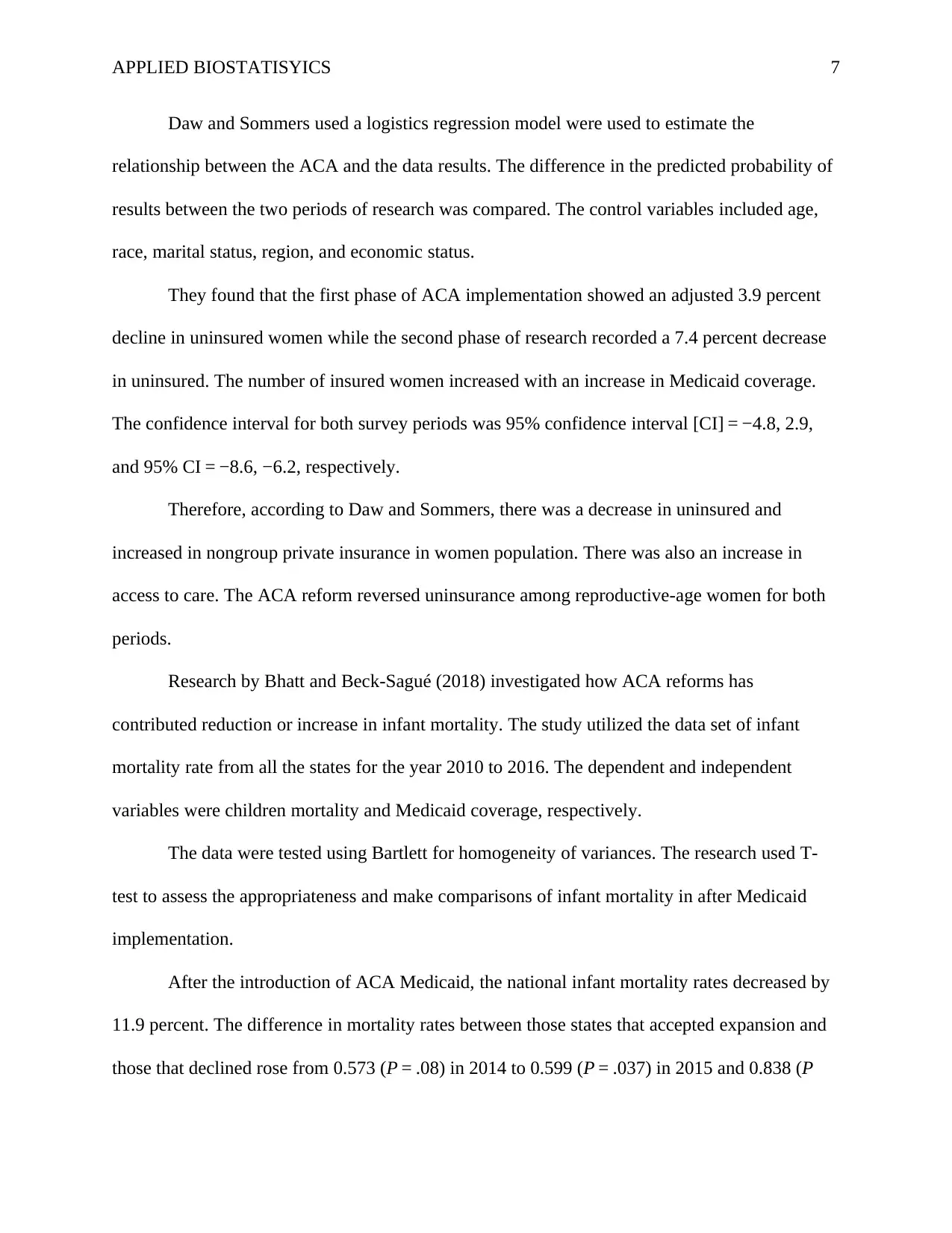
APPLIED BIOSTATISYICS 7
Daw and Sommers used a logistics regression model were used to estimate the
relationship between the ACA and the data results. The difference in the predicted probability of
results between the two periods of research was compared. The control variables included age,
race, marital status, region, and economic status.
They found that the first phase of ACA implementation showed an adjusted 3.9 percent
decline in uninsured women while the second phase of research recorded a 7.4 percent decrease
in uninsured. The number of insured women increased with an increase in Medicaid coverage.
The confidence interval for both survey periods was 95% confidence interval [CI] = −4.8, 2.9,
and 95% CI = −8.6, −6.2, respectively.
Therefore, according to Daw and Sommers, there was a decrease in uninsured and
increased in nongroup private insurance in women population. There was also an increase in
access to care. The ACA reform reversed uninsurance among reproductive-age women for both
periods.
Research by Bhatt and Beck-Sagué (2018) investigated how ACA reforms has
contributed reduction or increase in infant mortality. The study utilized the data set of infant
mortality rate from all the states for the year 2010 to 2016. The dependent and independent
variables were children mortality and Medicaid coverage, respectively.
The data were tested using Bartlett for homogeneity of variances. The research used T-
test to assess the appropriateness and make comparisons of infant mortality in after Medicaid
implementation.
After the introduction of ACA Medicaid, the national infant mortality rates decreased by
11.9 percent. The difference in mortality rates between those states that accepted expansion and
those that declined rose from 0.573 (P = .08) in 2014 to 0.599 (P = .037) in 2015 and 0.838 (P
Daw and Sommers used a logistics regression model were used to estimate the
relationship between the ACA and the data results. The difference in the predicted probability of
results between the two periods of research was compared. The control variables included age,
race, marital status, region, and economic status.
They found that the first phase of ACA implementation showed an adjusted 3.9 percent
decline in uninsured women while the second phase of research recorded a 7.4 percent decrease
in uninsured. The number of insured women increased with an increase in Medicaid coverage.
The confidence interval for both survey periods was 95% confidence interval [CI] = −4.8, 2.9,
and 95% CI = −8.6, −6.2, respectively.
Therefore, according to Daw and Sommers, there was a decrease in uninsured and
increased in nongroup private insurance in women population. There was also an increase in
access to care. The ACA reform reversed uninsurance among reproductive-age women for both
periods.
Research by Bhatt and Beck-Sagué (2018) investigated how ACA reforms has
contributed reduction or increase in infant mortality. The study utilized the data set of infant
mortality rate from all the states for the year 2010 to 2016. The dependent and independent
variables were children mortality and Medicaid coverage, respectively.
The data were tested using Bartlett for homogeneity of variances. The research used T-
test to assess the appropriateness and make comparisons of infant mortality in after Medicaid
implementation.
After the introduction of ACA Medicaid, the national infant mortality rates decreased by
11.9 percent. The difference in mortality rates between those states that accepted expansion and
those that declined rose from 0.573 (P = .08) in 2014 to 0.599 (P = .037) in 2015 and 0.838 (P
Paraphrase This Document
Need a fresh take? Get an instant paraphrase of this document with our AI Paraphraser
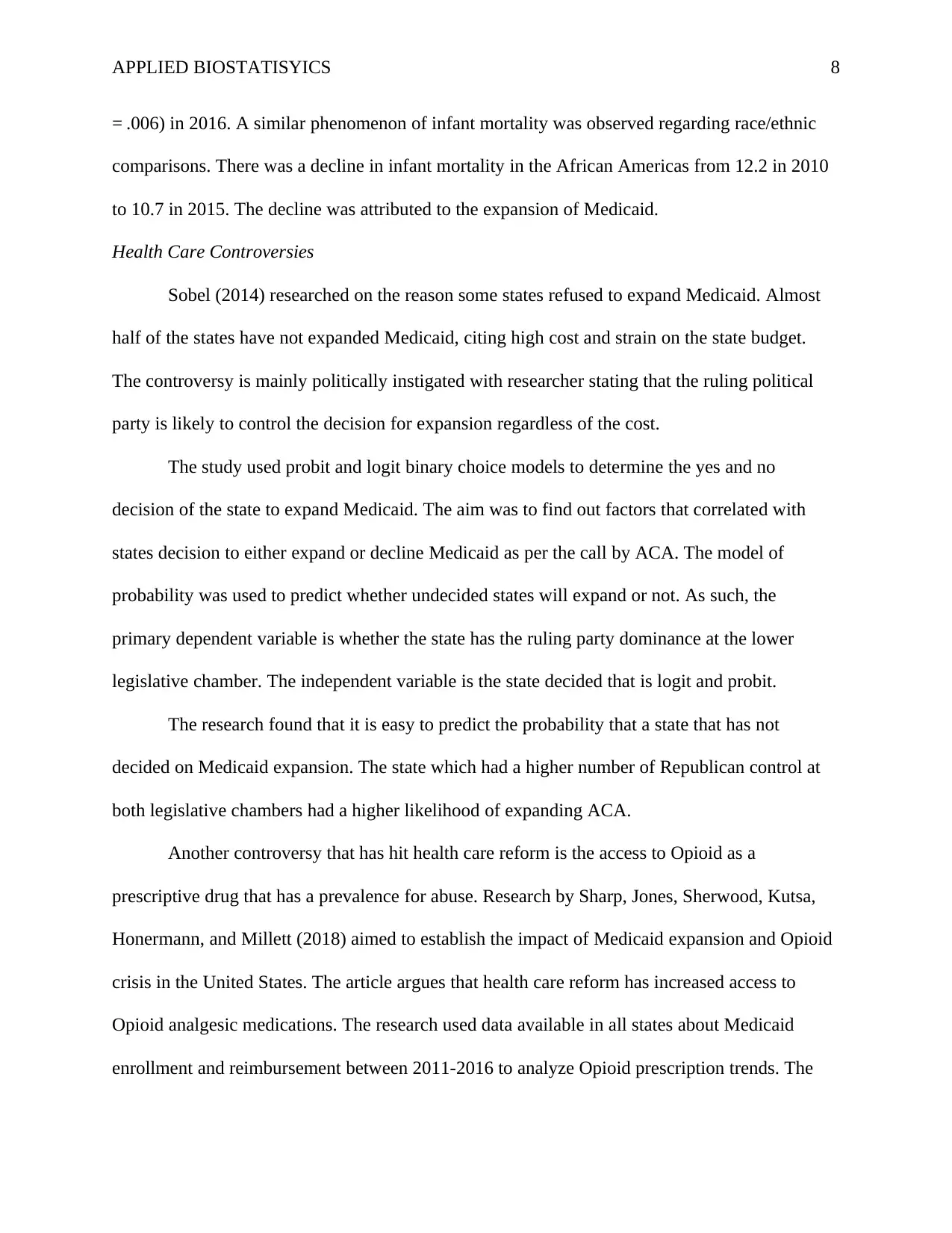
APPLIED BIOSTATISYICS 8
= .006) in 2016. A similar phenomenon of infant mortality was observed regarding race/ethnic
comparisons. There was a decline in infant mortality in the African Americas from 12.2 in 2010
to 10.7 in 2015. The decline was attributed to the expansion of Medicaid.
Health Care Controversies
Sobel (2014) researched on the reason some states refused to expand Medicaid. Almost
half of the states have not expanded Medicaid, citing high cost and strain on the state budget.
The controversy is mainly politically instigated with researcher stating that the ruling political
party is likely to control the decision for expansion regardless of the cost.
The study used probit and logit binary choice models to determine the yes and no
decision of the state to expand Medicaid. The aim was to find out factors that correlated with
states decision to either expand or decline Medicaid as per the call by ACA. The model of
probability was used to predict whether undecided states will expand or not. As such, the
primary dependent variable is whether the state has the ruling party dominance at the lower
legislative chamber. The independent variable is the state decided that is logit and probit.
The research found that it is easy to predict the probability that a state that has not
decided on Medicaid expansion. The state which had a higher number of Republican control at
both legislative chambers had a higher likelihood of expanding ACA.
Another controversy that has hit health care reform is the access to Opioid as a
prescriptive drug that has a prevalence for abuse. Research by Sharp, Jones, Sherwood, Kutsa,
Honermann, and Millett (2018) aimed to establish the impact of Medicaid expansion and Opioid
crisis in the United States. The article argues that health care reform has increased access to
Opioid analgesic medications. The research used data available in all states about Medicaid
enrollment and reimbursement between 2011-2016 to analyze Opioid prescription trends. The
= .006) in 2016. A similar phenomenon of infant mortality was observed regarding race/ethnic
comparisons. There was a decline in infant mortality in the African Americas from 12.2 in 2010
to 10.7 in 2015. The decline was attributed to the expansion of Medicaid.
Health Care Controversies
Sobel (2014) researched on the reason some states refused to expand Medicaid. Almost
half of the states have not expanded Medicaid, citing high cost and strain on the state budget.
The controversy is mainly politically instigated with researcher stating that the ruling political
party is likely to control the decision for expansion regardless of the cost.
The study used probit and logit binary choice models to determine the yes and no
decision of the state to expand Medicaid. The aim was to find out factors that correlated with
states decision to either expand or decline Medicaid as per the call by ACA. The model of
probability was used to predict whether undecided states will expand or not. As such, the
primary dependent variable is whether the state has the ruling party dominance at the lower
legislative chamber. The independent variable is the state decided that is logit and probit.
The research found that it is easy to predict the probability that a state that has not
decided on Medicaid expansion. The state which had a higher number of Republican control at
both legislative chambers had a higher likelihood of expanding ACA.
Another controversy that has hit health care reform is the access to Opioid as a
prescriptive drug that has a prevalence for abuse. Research by Sharp, Jones, Sherwood, Kutsa,
Honermann, and Millett (2018) aimed to establish the impact of Medicaid expansion and Opioid
crisis in the United States. The article argues that health care reform has increased access to
Opioid analgesic medications. The research used data available in all states about Medicaid
enrollment and reimbursement between 2011-2016 to analyze Opioid prescription trends. The
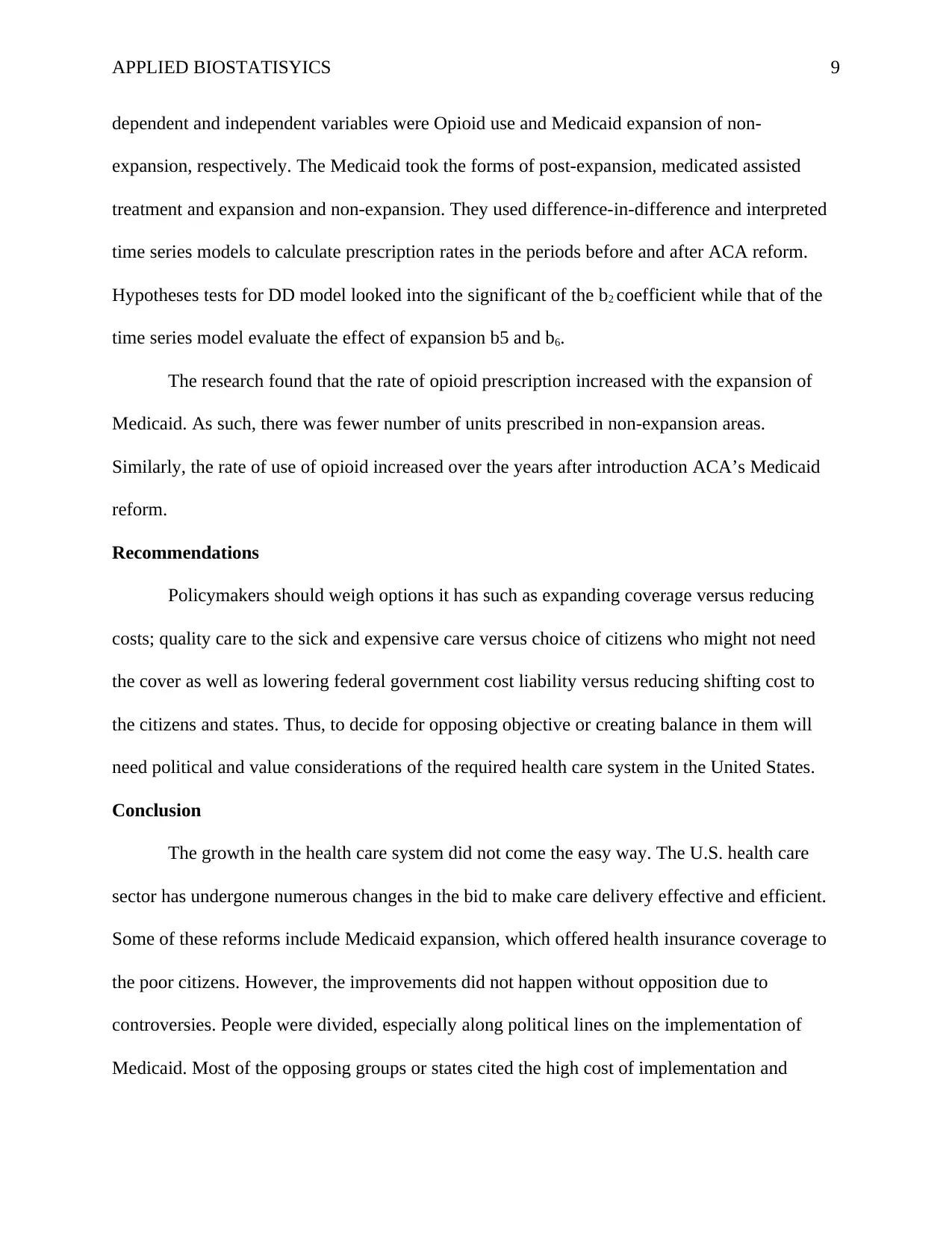
APPLIED BIOSTATISYICS 9
dependent and independent variables were Opioid use and Medicaid expansion of non-
expansion, respectively. The Medicaid took the forms of post-expansion, medicated assisted
treatment and expansion and non-expansion. They used difference-in-difference and interpreted
time series models to calculate prescription rates in the periods before and after ACA reform.
Hypotheses tests for DD model looked into the significant of the b2 coefficient while that of the
time series model evaluate the effect of expansion b5 and b6.
The research found that the rate of opioid prescription increased with the expansion of
Medicaid. As such, there was fewer number of units prescribed in non-expansion areas.
Similarly, the rate of use of opioid increased over the years after introduction ACA’s Medicaid
reform.
Recommendations
Policymakers should weigh options it has such as expanding coverage versus reducing
costs; quality care to the sick and expensive care versus choice of citizens who might not need
the cover as well as lowering federal government cost liability versus reducing shifting cost to
the citizens and states. Thus, to decide for opposing objective or creating balance in them will
need political and value considerations of the required health care system in the United States.
Conclusion
The growth in the health care system did not come the easy way. The U.S. health care
sector has undergone numerous changes in the bid to make care delivery effective and efficient.
Some of these reforms include Medicaid expansion, which offered health insurance coverage to
the poor citizens. However, the improvements did not happen without opposition due to
controversies. People were divided, especially along political lines on the implementation of
Medicaid. Most of the opposing groups or states cited the high cost of implementation and
dependent and independent variables were Opioid use and Medicaid expansion of non-
expansion, respectively. The Medicaid took the forms of post-expansion, medicated assisted
treatment and expansion and non-expansion. They used difference-in-difference and interpreted
time series models to calculate prescription rates in the periods before and after ACA reform.
Hypotheses tests for DD model looked into the significant of the b2 coefficient while that of the
time series model evaluate the effect of expansion b5 and b6.
The research found that the rate of opioid prescription increased with the expansion of
Medicaid. As such, there was fewer number of units prescribed in non-expansion areas.
Similarly, the rate of use of opioid increased over the years after introduction ACA’s Medicaid
reform.
Recommendations
Policymakers should weigh options it has such as expanding coverage versus reducing
costs; quality care to the sick and expensive care versus choice of citizens who might not need
the cover as well as lowering federal government cost liability versus reducing shifting cost to
the citizens and states. Thus, to decide for opposing objective or creating balance in them will
need political and value considerations of the required health care system in the United States.
Conclusion
The growth in the health care system did not come the easy way. The U.S. health care
sector has undergone numerous changes in the bid to make care delivery effective and efficient.
Some of these reforms include Medicaid expansion, which offered health insurance coverage to
the poor citizens. However, the improvements did not happen without opposition due to
controversies. People were divided, especially along political lines on the implementation of
Medicaid. Most of the opposing groups or states cited the high cost of implementation and

APPLIED BIOSTATISYICS 10
unsustainability, among other things. Therefore, reforms in health care should be continuous to
factor in the changes and needs occurring over time.
unsustainability, among other things. Therefore, reforms in health care should be continuous to
factor in the changes and needs occurring over time.
Secure Best Marks with AI Grader
Need help grading? Try our AI Grader for instant feedback on your assignments.
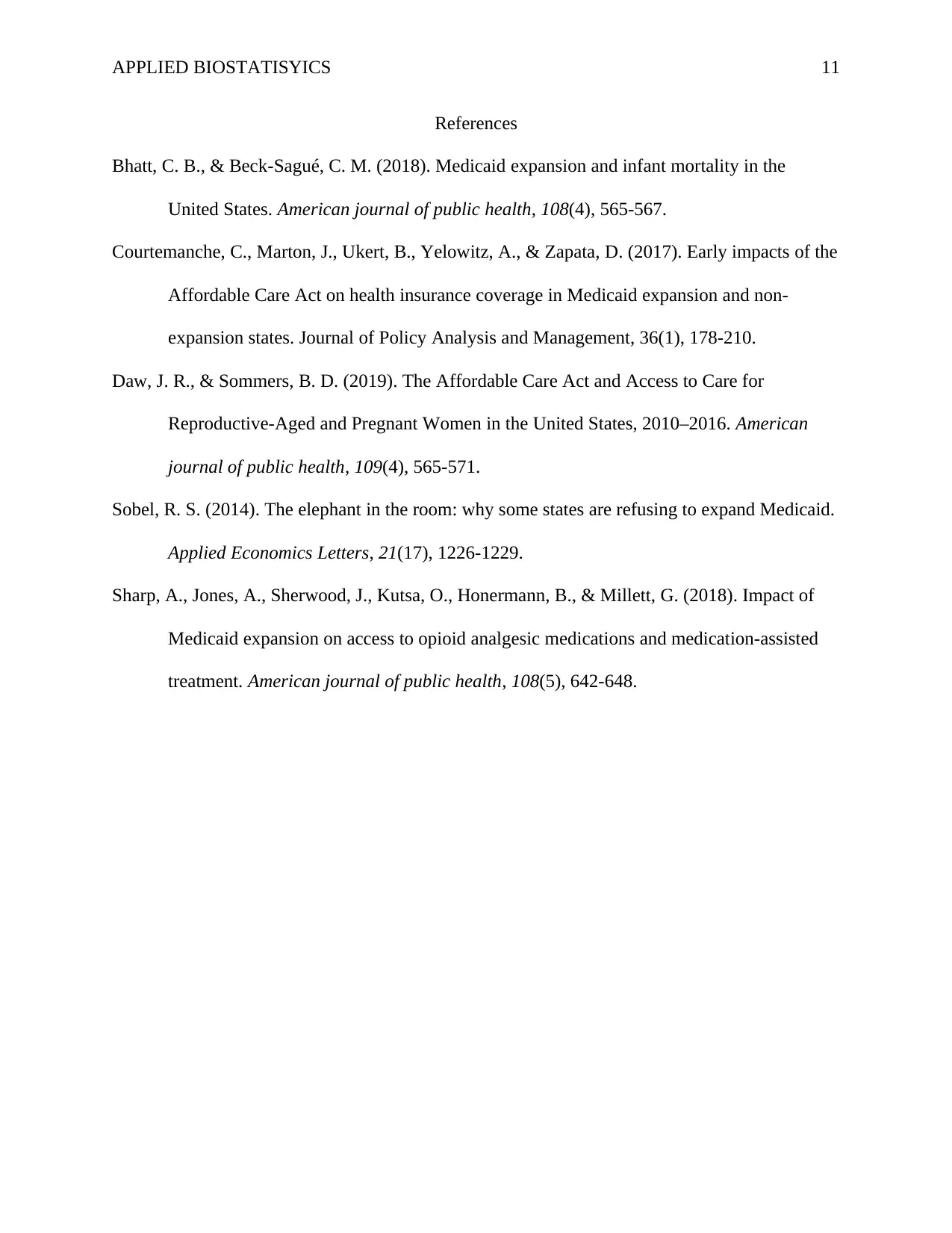
APPLIED BIOSTATISYICS 11
References
Bhatt, C. B., & Beck-Sagué, C. M. (2018). Medicaid expansion and infant mortality in the
United States. American journal of public health, 108(4), 565-567.
Courtemanche, C., Marton, J., Ukert, B., Yelowitz, A., & Zapata, D. (2017). Early impacts of the
Affordable Care Act on health insurance coverage in Medicaid expansion and non‐
expansion states. Journal of Policy Analysis and Management, 36(1), 178-210.
Daw, J. R., & Sommers, B. D. (2019). The Affordable Care Act and Access to Care for
Reproductive-Aged and Pregnant Women in the United States, 2010–2016. American
journal of public health, 109(4), 565-571.
Sobel, R. S. (2014). The elephant in the room: why some states are refusing to expand Medicaid.
Applied Economics Letters, 21(17), 1226-1229.
Sharp, A., Jones, A., Sherwood, J., Kutsa, O., Honermann, B., & Millett, G. (2018). Impact of
Medicaid expansion on access to opioid analgesic medications and medication-assisted
treatment. American journal of public health, 108(5), 642-648.
References
Bhatt, C. B., & Beck-Sagué, C. M. (2018). Medicaid expansion and infant mortality in the
United States. American journal of public health, 108(4), 565-567.
Courtemanche, C., Marton, J., Ukert, B., Yelowitz, A., & Zapata, D. (2017). Early impacts of the
Affordable Care Act on health insurance coverage in Medicaid expansion and non‐
expansion states. Journal of Policy Analysis and Management, 36(1), 178-210.
Daw, J. R., & Sommers, B. D. (2019). The Affordable Care Act and Access to Care for
Reproductive-Aged and Pregnant Women in the United States, 2010–2016. American
journal of public health, 109(4), 565-571.
Sobel, R. S. (2014). The elephant in the room: why some states are refusing to expand Medicaid.
Applied Economics Letters, 21(17), 1226-1229.
Sharp, A., Jones, A., Sherwood, J., Kutsa, O., Honermann, B., & Millett, G. (2018). Impact of
Medicaid expansion on access to opioid analgesic medications and medication-assisted
treatment. American journal of public health, 108(5), 642-648.
1 out of 11
Related Documents
Your All-in-One AI-Powered Toolkit for Academic Success.
+13062052269
info@desklib.com
Available 24*7 on WhatsApp / Email
![[object Object]](/_next/static/media/star-bottom.7253800d.svg)
Unlock your academic potential
© 2024 | Zucol Services PVT LTD | All rights reserved.





